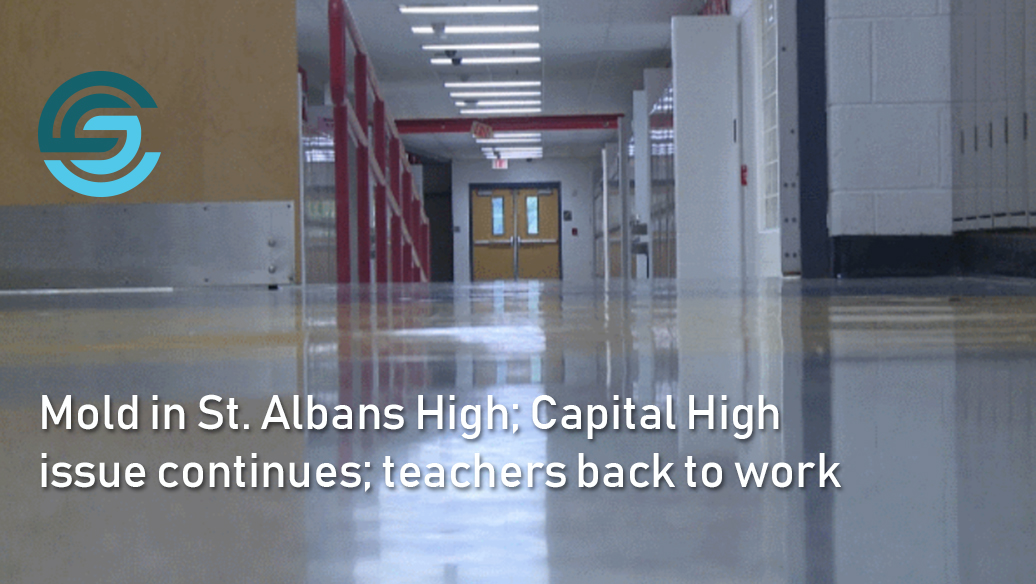[tm_pb_section admin_label=”section”][tm_pb_row admin_label=”Row”][tm_pb_column type=”4_4″][tm_pb_divider admin_label=”Divider” color=”#ffffff” show_divider=”off” height=”50″ height_last_edited=”on|phone” divider_style=”solid”]
[/tm_pb_divider][/tm_pb_column][/tm_pb_row][tm_pb_row admin_label=”Row”][tm_pb_column type=”4_4″][tm_pb_text admin_label=”Text” text_orientation=”justified” use_border_color=”off” border_color=”#ffffff” border_style=”solid”]
Testing showed elevated mold levels in St. Albans High’s library, counselor suite, computer lab and 12 classrooms, and “these rooms should be closed until the follow-up testing shows that rooms are clear,” the Kanawha County school system’s communications chief wrote Monday.
Communications Director Briana Warner said in an email that Charleston-based Astar Abatement & Insulation cleaned those rooms last week, and Ohio- and West Virginia-based Pinnacle Environmental Consultants Inc. tested them Monday.
School administrators were asked Monday about St. Albans’ mold issues after the Gazette-Mail received multiple reports about them.
Warner also wrote Monday that elevated mold continued to be detected in six classrooms after cleaning at Capital High in Charleston, where news media reported mold issues around the start of this month.
“Belfor is back cleaning those six rooms today,” Warner wrote of the company that has been doing the cleaning there. “We will re-test in these six academic rooms, plus additional rooms in this wing.”
Before Warner’s statement Monday afternoon, St. Albans Principal Jeff Kelley said that, when teachers and cooks return to work Tuesday, “right now the only two areas that they’ve told us that we’re not going to be working in are the library and the counseling center.” He said other staff members already have returned to the school.
New Assistant Principal Dan Heumann said the school’s head custodian relayed the recommendation to close those two rooms, but Heumann didn’t know where it initially came from.
Kelley said he didn’t have the pre- or post-cleaning testing results Monday afternoon and didn’t know which rooms had been tested or cleaned. He said he was out of the school for a school system meeting Thursday and Friday and was away over the weekend, and it was over that period that the cleaning occurred.
He said a school custodian first reported seeing mold within probably the past two weeks, and “there was no indication that anybody was sick or that they were having any type of reaction to it.”
Warner wrote, “we do not anticipate delaying the start of classes” this coming Monday.
At Capital, “elevations” of mold, as Pinnacle worded it in a report, were detected July 16 and July 17, and Warner wrote that visible mold was found in several classrooms there. Kanawha brought in international company Belfor Property Restoration to clean that school.
Warner wrote that teachers will return to Capital on Tuesday and “the principal can work with any affected teachers to grant them additional space this week until their room has been cleared. “
The school system closed Capital for most of a week in September 2017 after test results of initial air sampling back then revealed elevated levels of mold and carbon dioxide there. St. Albans has also had repeated mold issues.
In 2016, schools Maintenance Director Terry Hollandsworth said St. Albans administrators reported visible mold there, and Belfor cleaned the freshman wing and library before classes began. After school started, more visible mold was reported on a St. Albans band instrument case and another piece of equipment in the band room, and Belfor cleaned more.
There was more cleaning and, on at least the fourth round, Belfor again cleaned the library and rooms adjacent to the library and a hallway. Following even more testing, the hallway still had elevated mold levels.
2010, mold accumulated on books in the school’s library.
On Monday, Kelley said the initial information he received from the county indicated that the possible mold issue this time is not on the band room side of the building, but in the east wing of the building.
Kelley said the reports, which he’s expecting this week, will show the status of individual rooms, and will show “if there needs to be further testing or cleaning.”
Hollandsworth declined to speak Monday about the issues, saying answers would have to come through Warner.
Kelley said the school has had issues with cooling and reducing humidity.
The Kanawha Board of Education is asking residents to approve in the November election raising property taxes, mostly to provide $108.5 million for heating, ventilation and air-conditioning improvements over five years to 15 schools, including six of the eight high schools.
Source: Charleston Gazette-Mail
[/tm_pb_text][/tm_pb_column][/tm_pb_row][tm_pb_row admin_label=”row”][tm_pb_column type=”4_4″][tm_pb_divider admin_label=”Divider” color=”#ffffff” show_divider=”off” height=”20″ height_last_edited=”on|phone” divider_style=”solid”]
[/tm_pb_divider][/tm_pb_column][/tm_pb_row][/tm_pb_section]

